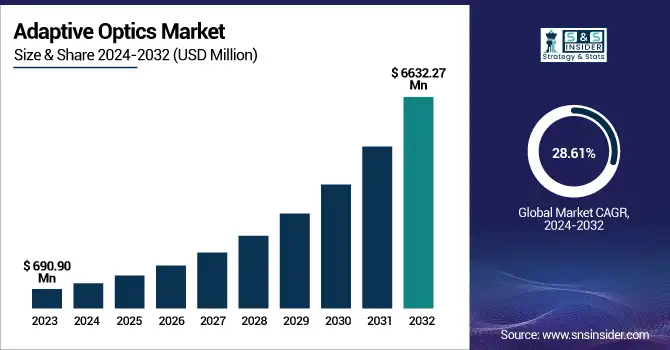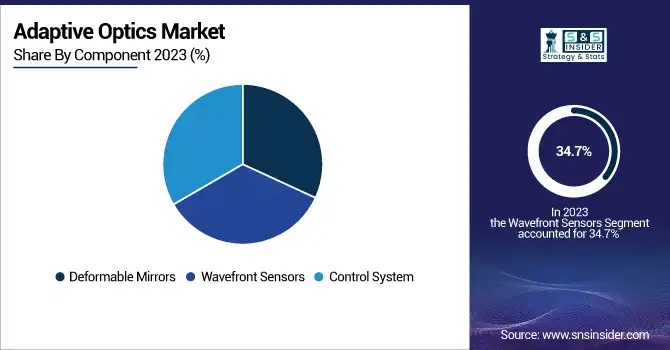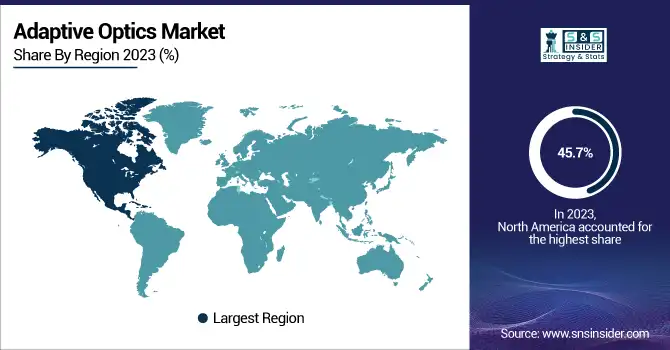Adaptive Optics Market Size & Trends:
The Adaptive Optics Market was valued at USD 690.90 million in 2023 and is expected to reach USD 6632.27 million by 2032, growing at a CAGR of 28.61% over the forecast period 2024-2032. Adaptive Optics Market is opening up newer avenues in quantum optics & photonics segments to ensure precision in quantum communication & computing. Fab utilization metrics show the increased adoption in semiconductor lithography and optical systems. Fabrication of Deformable Mirrors and Wavefront Sensors in Systems-level Production & Manufacturing Trends AI & Computational Optics Enhancements in Real-time and Adaptive Image and Wavefront Correction.

To Get more information on Adaptive Optics Market - Request Free Sample Report
Adaptive optics is widely applied in many fields in the US. For example, adaptive optics used in detail retinal imaging by the National Eye Institute has improved some diagnostic measures in ophthalmology. Meanwhile, in the defense industry, Boston Micromachines Corporation partners with NASA and the U.S. Naval Research Laboratory on adaptive optics systems for laser weapons or satellite tracking. U.S. Adaptive Optics Market size was valued at USD 240.93 Million in 2023 and the total Adaptive Optics revenue is expected to grow at a CAGR of 28.47% from 2024 to 2032. The U.S. Adaptive Optics Market is driven by the integration of Artificial Intelligence and Adaptive optics, advancement in astronomy, defense, and biomedical imaging, lasers communication, government funding, and the burgeoning demand for high precise optical systems.
Adaptive Optics Market Dynamics
Key Drivers:
-
Revolutionizing Imaging and Precision Optics with Adaptive Optics Technology Across Healthcare Defense and Communication
Demand for high-resolution imaging and precision optics is one of the primary drivers of the adaptive optics market. Adaptive optics is commonly used across industries for wavefront correction, such as in astronomy, ophthalmology, microscopy, and defense for both image reconstructing and system correction to achieve a clearer actual function output. Market growth is being driven by the increasing adoption of adaptive optics in healthcare, notably for retinal imaging and laser eye surgeries for ophthalmology applications. In addition, the increased use of adaptive optics to improve data transmission capability for laser communication and free-space optical (FSO) communication has provided a key technology for next-generation satellite and terrestrial networks. In the defense realm, adaptive optics is crucial for surveillance, missile tracking, and directed energy weapons and therefore represents a huge market as well.
Restrain:
-
Challenges in Adaptive Optics Market Growth Due to System Integration Complexity Technical Issues and Sensitivity
The main factors restraining the growth of the global adaptive optics market are complications in system integration and technical issues. This requires adaptive optics systems to be well calibrated, perform wavefront correction in real-time, and fit with optical and electronic parts with minimum downtime. This complexity has prevented adaptive optics from being used in a variety of applications by end-users without specialized training. Moreover, environmental factors like turbulence, vibrations, and temperature variations may impact the performance of the system, which needs constant adjustments and advanced control systems. Adaptive optics are (very) sensitive to external disturbances and thus exhibit an inconsistency in the operation that makes them unsuitable for many outdoor and aerospace applications, where stability of operation is key.
Opportunity:
-
AI and Machine Learning Driving Next Generation Adaptive Optics Innovations in Imaging Quantum Computing and Lasers
The largest opportunity within the adaptive optics market stems from integrating AI and machine learning (ML) to enable real-time adaptive correction. Automating wavefront adjustments and visualizing optical performance through AI-powered algorithms will be transformative for applications in autonomous vehicles, biomedical imaging, and industrial laser processing. Not to mention the growing applications of adaptive optics in quantum computing and next-gen displays. Increasing demand for ultrafast optical systems and high-precision laser applications will provide emerging markets with lucrative opportunities for adaptive optics research and development and innovation in products.
Challenges:
-
Lack of Standardization and Skilled Experts Hinders Adaptive Optics Adoption Across Industries and Applications
Another big hurdle is that the field lacks the needed standards and expertise. The wide-ranging applications of adaptive optics technologies, from astronomy to healthcare and defense, have resulted in a scattering of efforts around standards for implementation. This absence of standardization makes interoperability between different components and systems problematic and presents barriers to widespread adoption. There is also a significant lack of qualified engineers and researchers available to develop, operate, and maintain these extremely specialized systems. While these challenges with the use of adaptive optics can present a barrier to adoption, as adaptive optics technology matures, need to ensure that the talent to work with these technologies and that best practices are established within the industry.
Adaptive Optics Industry Segment Analysis
By Component
In 2023, Wavefront Sensors dominated the adaptive optics market with a 34.7% share, due to its significant contribution in detecting optical distortions and guiding corrective elements in many applications such as astronomy, microscopy, and ophthalmology. They have become an important component in high-resolution optical systems due to their capacity to improve image quality and accuracy. The rising need for cutting-edge imaging solutions across healthcare and laser-based applications also drove their substantial share in the market.
Deformable mirrors (wavefront correctors) are expected to witness the fastest CAGR during 2024-2032, as these devices are being increasingly used in high-performance laser systems, free-space optical communication, and defense applications. So-called adaptive optics mirrors serve the key function of dynamically compensating for distorted wavefronts, which is critical for the performance of laser beams and optical systems. Although lacking in number for now, the market is expected to attain significant growth in the coming years owing to the constant developments in the field of AI-driven adaptive optics and the miniaturization technologies for Deformable Mirrors.

By End-use
In 2023, Microscopy accounted for 20.6% adaptive optics market driven by biomedical imaging, life sciences, and material research. By correcting optical aberrations, adaptive optics technology greatly improves the spatial resolution and clarity of microscopic imaging and can now be used to visualize cellular structures and biological processes in vivo with unprecedented detail. Microscopy has dominated the market due to the increasing adoption of advanced fluorescence and multiphoton microscopy in medical diagnostics and drug discovery.
Communications are projected to grow at the highest from 2024 to 2032 owing to growing communication Technologies like free-space optical (FSO) communication, satellite-based internet, and high-speed data transmission technologies. Adaptive optics therefore contributes greatly to the physical layer of the optical communication system to prevent atmospheric distortions, which allows for improvement in the quality of the signal and efficiency of the transmission. Adaptive optics in communications are also poised for strong growth as the demand for next-generation optical networks and deep-space communication continues to mature.
Adaptive Optics Market Regional Landscape
North America held the largest market share of 45.7% of the adaptive optics market in 2023 and is expected to continue growing due to high investments in defense, healthcare, and aerospace in the region. To a large extent, the region's leadership is built on the backs of key players such as NASA, Lockheed Martin, and Northrop Grumman, which apply adaptive optics in satellite imaging, missile defense systems, and astronomical observatories. Exemplary institutions doing research at the frontiers of biology, like the Harvard Medical School and the Lawrence Livermore National Laboratory, are based in the U.S., where they utilize adaptive optics to achieve high-resolution biomedical imaging and laser applications. Further increase in utilization of adaptive optics in companies such as Johnson & Johnson Vision and Alcon for ophthalmology and laser eye surgeries is expected to propel the market growth.
Asia Pacific is projected to have the fastest car in the market between 2024 and 2032 due to the growing investments in optical communication, semiconductor fabrication, and defense applications. China, Japan, and South Korea lead the world, with, e.g. Chinese Academy of Sciences' adaptive optics for astronomical telescopes and quantum communication. Canon and Nikon are pushing the limits of adaptive optics for microscopy and precision imaging technologies in Japan, while ISRO (Indian Space Research Organization) in India is embracing adaptive optics in satellite tracking and deep-space missions. Following the rapid market growth in telecommunications for adaptive optics with the contained expansion of 5G and fiber-optics networks in Asia Pacific and emerging applications in LiDAR-based automotive will be early signs of fully matured economies in the adoption of modern adaptive optics applications.

Get Customized Report as per Your Business Requirement - Enquiry Now
Key Players Listed in Adaptive Optics Market are:
-
Northrop Grumman Corporation (Xinetics Adaptive Optics Solutions)
-
Thorlabs, Inc. (Deformable Mirrors)
-
Boston Micromachines Corporation (MEMS Deformable Mirrors)
-
Imagine Eyes (HASO Wavefront Sensors)
-
Iris AO, Inc. (MEMS-Based Deformable Mirrors)
-
Adaptica (Vision Assessment Devices)
-
IMAGINE OPTIC SA (Wavefront Analyzers)
-
ALPAO (Deformable Mirrors)
-
Optico AG Sevelen (Optical Components)
-
AKA Optics SAS (Optical Systems)
-
PHASICS CORP (Wavefront Sensors)
-
Flexible Optical B.V. (OKO Technologies) (Adaptive Optical Systems)
-
Teledyne e2v (UK) Ltd (Imaging Sensors)
-
Synopsys Optical Solution Group (Optical Design Software)
-
Holoeye Photonics AG (Spatial Light Modulators).
Recent Trends
-
In March 2025, Imagine Eyes partners with Emsere to expand access to advanced retinal imaging in clinical trials, enhancing precision in monitoring retinal diseases. The collaboration aims to streamline the deployment of adaptive optics technology for improved research and drug development.
-
In July 2024, ALPAO rebranded as Bertin Alpao following its acquisition by Bertin Technologies, strengthening its position in adaptive optics.
| Report Attributes | Details |
|---|---|
| Market Size in 2023 | USD 690.90 Million |
| Market Size by 2032 | USD 6632.27 Million |
| CAGR | CAGR of 28.61% From 2024 to 2032 |
| Base Year | 2023 |
| Forecast Period | 2024-2032 |
| Historical Data | 2020-2022 |
| Report Scope & Coverage | Market Size, Segments Analysis, Competitive Landscape, Regional Analysis, DROC & SWOT Analysis, Forecast Outlook |
| Key Segments | • By Component (Deformable Mirrors (Wavefront Correctors), Wavefront Sensors, Control System) • By End-use (Ophthalmology, Microscopy, Laser Application, Manufacturing, Communications, Military & Defense, Others) |
| Regional Analysis/Coverage | North America (US, Canada, Mexico), Europe (Eastern Europe [Poland, Romania, Hungary, Turkey, Rest of Eastern Europe] Western Europe] Germany, France, UK, Italy, Spain, Netherlands, Switzerland, Austria, Rest of Western Europe]), Asia Pacific (China, India, Japan, South Korea, Vietnam, Singapore, Australia, Rest of Asia Pacific), Middle East & Africa (Middle East [UAE, Egypt, Saudi Arabia, Qatar, Rest of Middle East], Africa [Nigeria, South Africa, Rest of Africa], Latin America (Brazil, Argentina, Colombia, Rest of Latin America) |
| Company Profiles | Northrop Grumman Corporation, Thorlabs Inc., Boston Micromachines Corporation, Imagine Eyes, Iris AO Inc., Adaptica, IMAGINE OPTIC SA, ALPAO, Optico AG Sevelen, AKA Optics SAS, PHASICS CORP, Flexible Optical B.V. (OKO Technologies), Teledyne e2v (UK) Ltd, Synopsys Optical Solution Group, Holoeye Photonics AG. |

